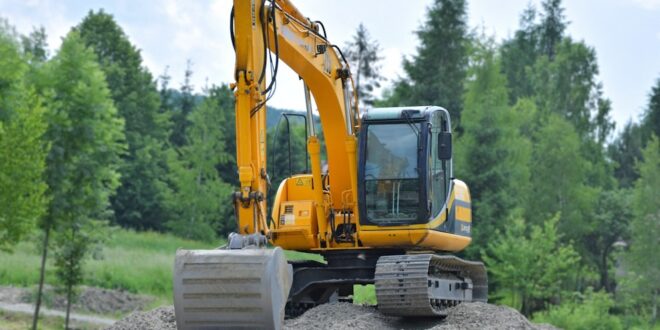Reprinted with permission from ACP Media, NZ Lifestyle Block
It can take a bit of digging to get the water where you want it on your property. An expert drainage operator shares some techniques on what it takes to make surface water go away.
It wasn’t a good day to visit a drain layer on the job. Shayne Bunn’s 16 tonne Hitachi digger sat idle. In the trench just beneath its tracks, a torn up telephone cable, ripped drainage pipe and shards of concrete from another drain, was the reason for the stoppage.
“Well, I suppose there’s a lesson here,” he says, “if people are looking at buying a block of land they should see if there’s a plan of what drainage has been installed and where the power and telephone cables are. And if you’re putting drainage in, make a plan so you don’t end up digging your drains up again later. It really helps – and stops expensive down time – if we can locate all the services, (and avoid them) before we start.”
Shayne, a drain layer for the last 18 years, works on a variety of rural, industrial and residential properties for Taranaki Civil Construction Ltd.
“The first thing we do is get our in-house surveyor in to look at the property – if it’s a flat property with a lot of surface water lying around and nowhere to drain to, you can have problems. Sometimes it can be hard to get enough depth for the outlet.”
The surveyor recommends the degree of slope needed to effectively drain the property and diameter pipe needed, and the diggers begin work. Effective drainage depends on the land configuration, soil porosity and what crops the owners intend using the block for and is best left to professionals. The same factors influence the spacing between drains.
“If it’s a really swampy area with a lot of springs running into it, we’ll dig a ring drain around it and leave it for a year or so to drain,” he explains. “Or we can find the springs and tap into them with Novaflow.”
Novaflow and Drainflo are the two most commonly used reinforced plastic drainage pipes. They are perforated to allow water access and heavy-duty versions are recommended for areas with especially soft ground or heavy wheel traffic. At least a depth of 0.75m, fully surrounded by gravel, is recommended for driveways.
“It’s a good idea for people to bring the ends of the Novaflow (or Drainflo) pipes about half a metre up out of the ground so they can flush them out if they get blocked,” Shayne adds. “And put a white painted stick beside them, so you don’t run them over with the mower by mistake.”
From pongas to lasers
“In the old days farmers would just dig a ditch and lay pongas in it – we’re still digging up old ponga drains,” he says. “The pongas don’t rot away because very little air gets to them.”
The manufacturers recommend a slope of 0.8 – 1.5 percent, or 800mm – 1.5m drop over a 100m run of drainpipe.
“That’s pretty easy these days – we just put a laser level in the pipe and it tells us exactly when we’ve got it right,” Shayne says.
A water flow of at least 0.5 m/sec is also recommended to flush any fine sand or silt that enters the pipe, to be flushed through. Drainflo manufacturers, Marley, recommend about 20m to 23m spacing between pipes in sand, 12m to 13m in loam, 5m to 6m in sandy clay, 14m to 15m in sandy loam, 7m to 8m in clay loam or 4m to 5m in clay. The pipes generally drain to a concrete culvert which feeds to a stormwater collection pond that may have a concrete “wing” wall (a concrete slab with two angled wings to channel water) and thence through an overflow drain to a waterway. Every system is different however and careful thought is often needed to prevent de-stabilising banks with carelessly placed water discharge.
Excavating
Once the system has been designed, the diggers excavate the trench, generally to about one metre deep. A fine cloth, Geogrid mat, is laid in it to stop dirt and silt from getting into the drainage pipe.
“In really soft ground we use Dura grid – a plastic mesh that stops the pipe from sinking into the ground,” Shayne says.
About 400mm of gravel, usually 40mm pea gravel, is laid below and above the pipe, then another layer of cloth laid over it before it is buried. The gravel fill should have a minimal number of particles below 1.5mm diameter according to Marley specifications.
A drain layer working in good conditions can lay about 400m to 500m of drainpipe a day, adds Shayne.
“A lot of the farmers in Taranaki are filling in their open drains or creeks with concrete pipes and covering them to gain extra pasture,” he says.
Planting trees can also improve the drainage properties of land and provide shelter for stock, stop erosion and improve riparian areas. Many local councils provide assistance, trees and advice, for riparian planting.
But drain laying has never been easier. Modern excavators have a variety of attachments to penetrate whatever soil or rock types, pipes are lighter and more efficient, and laser levelling gives a degree of accuracy old school drain layers could only dream about.
Those little lakes that used to form after every rainstorm can quickly become a thing of the past!
Author: Lindsay Wright









Join the Discussion
Type out your comment here:
You must be logged in to post a comment.